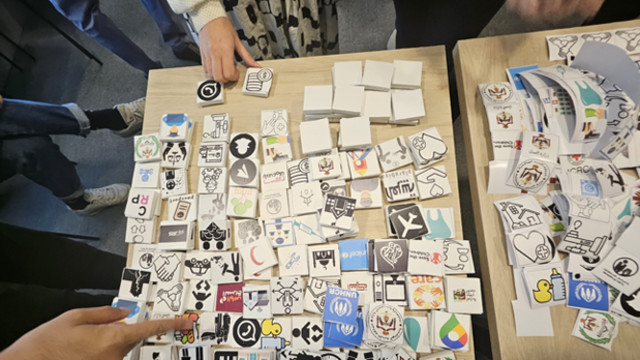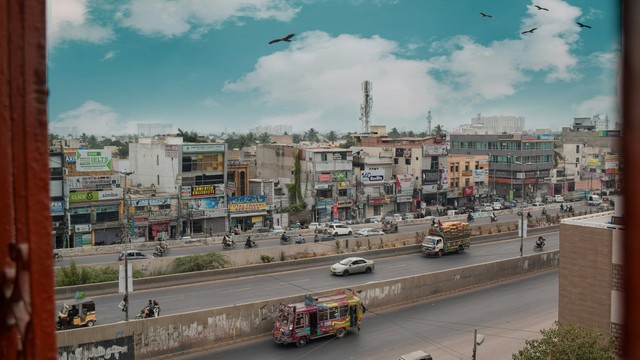Refugee voices at the summit
The process of gathering data about refugees often overlooks refugee priorities. The data justice project aims to rectify this disparity by enabling refugee communities to collect data that reflects what matters to them most. Guest author Hala Ghanem reports from Jordan on what we learned.


The Data Justice for Refugees project used an innovative three-dimensional tool to generate conversations about the challenges and priorities of refugees in Jordan (Photo: Data Justice for Refugees project team)
Last month in Amman, around 50 representatives from various refugee communities across Jordan came together for a crucial conversation. Their mission? To delve into the specific challenges faced by individual refugee communities while also exploring how these challenges intersect with the broader collective experiences and priorities of refugee communities as a whole.
Amid the discussions, a question arose: "Is there scope to hope?"
Jordan, a country of 11 million people, hosts more than 1.3 million refugees, primarily Syrians. During our workshops, many participants expressed their frustration, having lived as refugees in Jordan for over a decade. They feel treated more like humanitarian cases than individuals with rights desiring full, meaningful lives. The conversation largely centred on identifying shared strategies to challenge the current status quo.
This significant meeting of minds and hearts was orchestrated by the Data Justice for Refugees research project. The project's starting point was the recognition that data collection about refugees by humanitarian agencies, governments and researchers can shape the assessment of their needs and the type of humanitarian aid they receive. The priorities and motivations guiding data collection are often different from those championed by refugees.
Funded by Open Society Foundations and implemented by IIED and the Information and Research Centre at the King Hussein Foundation, the data justice project advocated for tools that support refugee communities to collect data that reflects their collective priorities. Most researchers on the project were from refugee communities.
How can data serve refugees, instead of merely portraying them?
This project has relied on an arts-based approach to foster a participatory and engaging community data collection process to identify the core priorities of urban refugees in Jordan. We started with a comprehensive context analysis that covered both grey and scholarly literature (we put special emphasis on Arabic language sources, often overlooked).
We conducted five art workshops with around 50 refugee participants in total, representing diverse nationalities, ages, genders and abilities. We analysed the lessons that emerged from these participatory workshops and communicated it back to the participants at a community feedback event.
The event then featured discussions on which of the identified experiences and challenges could be prioritised for advocacy.
The three-dimensional pyramid: visualising voices
We recognised the need for a creative approach when designing the workshops. Refugees' experiences are incredibly diverse, reflecting a wide range of backgrounds, needs and aspirations. Our method needed to embrace this intersectionality, acknowledging the complex layers within refugee groups while also capturing the shared needs of the broader refugee community in Jordan.
We designed a large pyramid made of foam-board divided into four sides as an innovative tool to visualise priorities tangibly and interactively. We gave participants a collection of small cubes, each bearing a symbol representing different priorities. These cubes were to be attached to the pyramid, with the less critical issues at the bottom and the most pressing ones at the top.
The pyramid was divided into four quadrants, each representing a different refugee community – from specific age groups, such as children, to groups that face particular challenges, such as women or refugees with disabilities.
In each workshop, participants split into two teams, with each team receiving a pyramid. They selected three groups for three pyramid quadrants, while the fourth quadrant highlighted the collective needs of all refugee communities.
The cubes at participants' disposal featured symbols associated with critical areas such as health, family, education and legal matters. In recognition of the evolving nature of refugees' needs, some cubes were left blank. This allowed participants to introduce new priorities, using colours and pens to express them, an approach adapted from another art-based tool, the City of Refuge toolkit.
This method wasn't just about listing priorities; it was a powerful exercise in giving refugees a voice, enabling them to articulate and visualise their needs in a way that was both engaging and profoundly meaningful.
Stories do matter
When we set out to create our tool, we were fully aware of the research fatigue felt by most refugee communities. We wanted to introduce something fresh that would not only capture their interest but also provide a space for them to express themselves on their own terms, share their stories, and connect.
The pyramid's four-sided design had two main objectives. First, it sought to foster empathy among refugee groups towards each other by highlighting aspects of refugee lives that often remain hidden, such as the challenges faced by refugees in prisons, those dealing with mental health issues, autistic child refugees and women-led households.
Second, the quadrant dedicated to the wider refugee community encouraged participants to adopt a holistic perspective. This involved uniting them to collectively consider their priorities, thereby fostering a sense of unity and shared purpose across different communities. It emphasised the importance of a unified approach to refugee support while acknowledging that different groups have unique needs and priorities.
Discussions delved into the day-to-day challenges, highlighting specific issues such as Eritrean children's inability to enrol in Jordanian schools, and general challenges such as labour exploitation and the hurdles faced in opening bank accounts.
The way participants interacted with the tool was fascinating. In one workshop, participants placed the symbol representing the United Nations High Commissioner for Refugees upside down to signify how they experience its mandate to protect them. These interpretations sparked stories, prompted questions, encouraged a deeper exploration of each other's perspectives, and revealed personal priorities grounded in their experiences.
Not 'refugees': dreamers
One poignant drawing on a blank cube suggested that love should be considered a priority, highlighting the common struggles of refugee experiences. Bana (a pseudonym), an Iraqi single mother, suggested dedicating a section of the pyramid to those who dream of better lives, specifically asking not to label it as 'for refugees' but 'for dreamers'. This request fostered a collective mindset among her group, encouraging them to jointly imagine an alternative world for refugees.
The participants' powerful stories revealed deep insights, nurtured empathy and also laid bare the intricate tapestry of needs, ambitions and dreams characterising refugee communities. The team has crafted a policy brief to further the dialogue and pursue strategies that challenge the status quo, with advocacy as the next critical step.
Despite the significant tasks ahead for refugee justice, it is the participants themselves, through their stories and ability to collectively imagine a joint future, that provided the answer to the question "Is there scope to hope?". It is a resounding ‘Yes!’





